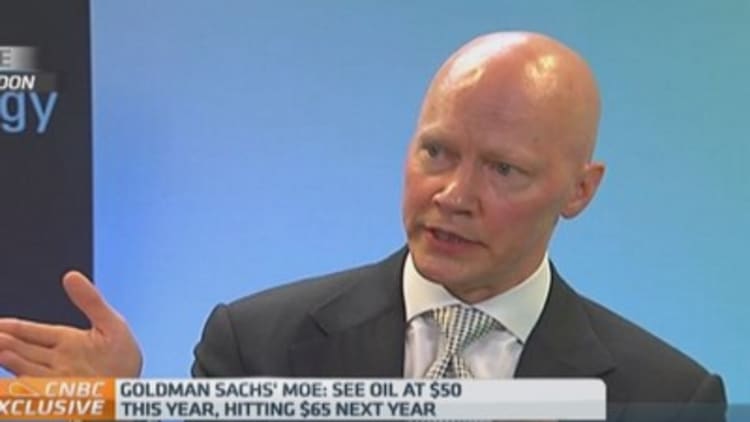
Goldman Sachs slashed its oil price forecasts, saying the market's "new normal" for crude means it's likely to remain lower for longer.
"The latest move is certainly a reflection of the clear shift in demand and supply fundamentals," Timothy Moe, co-head of economics, commodities and strategy, told CNBC at Goldman Sachs's strategy conference in London on Monday.
"We certainly did not expect the magnitude of the price decline in the second half of last year, so we have updated the demand and supply expectations."
On a three-, six- and 12-month basis, Brent will likely trade at $42, $43 and $70 a barrel, Goldman estimates, down from its previous $80, $85 and $90 a barrel forecasts, respectively.
For WTI, Goldman has $41, $39 and $65 a barrel forecasts on three-, six- and 12-month horizons, down from $70, $75 and $80 a barrel previously.
"This bear market will likely be characterized by more of a U-shaped recovery in which markets take longer to recover and will likely rebound to far lower price levels from where they sold off from," Goldman said in a note dated Sunday.
Read MoreWhy lower oil isn't giving Asia markets wings
U.S. E&P capex is already down 25 percent and drilling has dropped more quickly than in previous bear markets, but shale production can be restarted quickly with access to capital, it noted.
"The significant availability of low-cost external capital from either private equity or international majors exacerbates the need for sustained low prices to avoid these assets from quickly being redeployed in a lower cost environment," it said.
Shale production is a 12-month investment proposition, Goldman said, with producers hedging prices 9-12 months ahead, meaning that the one-year-ahead WTI swap must remain below the $65 a barrel marginal cost—or near $55 a barrel—for the next year to sideline capital and allow for the physical market to rebalance.
Oil prices have plunged more than 50 percent since mid-2014, dropping to their lowest levels since 2009.
In European trade Monday, Brent was trading around $48.61 a barrel and U.S. crude was around $47.04 a barrel.
In addition, the market now has "substantial" excess storage and tanker capacity, meaning it can run a surplus far longer than in the past, Goldman said, estimating sufficient capacity to store a million barrels a day of surplus for nearly a year.
Read MoreCheaper oil complicates war on climate change
"How low prices need to go is dependent upon the producer's view of the future," Goldman said. "Given the optimistic nature of the oil drilling business, producer views are unlikely to change until the environment becomes extremely hostile with prices low enough such that survival becomes questionable."
It also cited another factor likely to keep shale producers humming along: cost deflation, which has already lowered expenses by 25 percent. Not only have there been declines in other commodity prices, currency moves and lower rig rates, engineers have managed substantial productivity gains, it said.
—By CNBC.Com's Leslie Shaffer; with contribution from CNBC.com's Katy Barnato.


